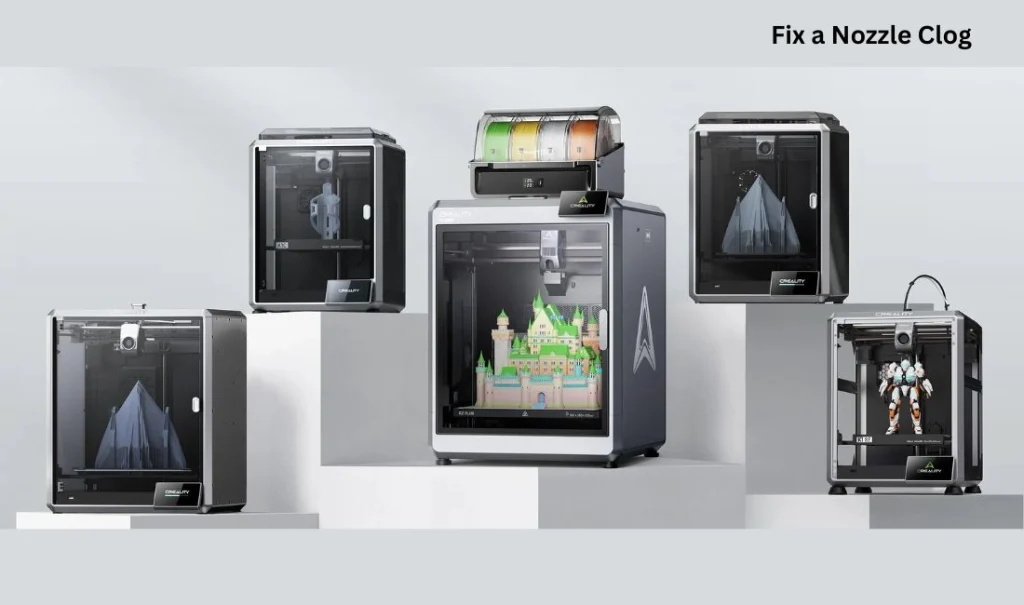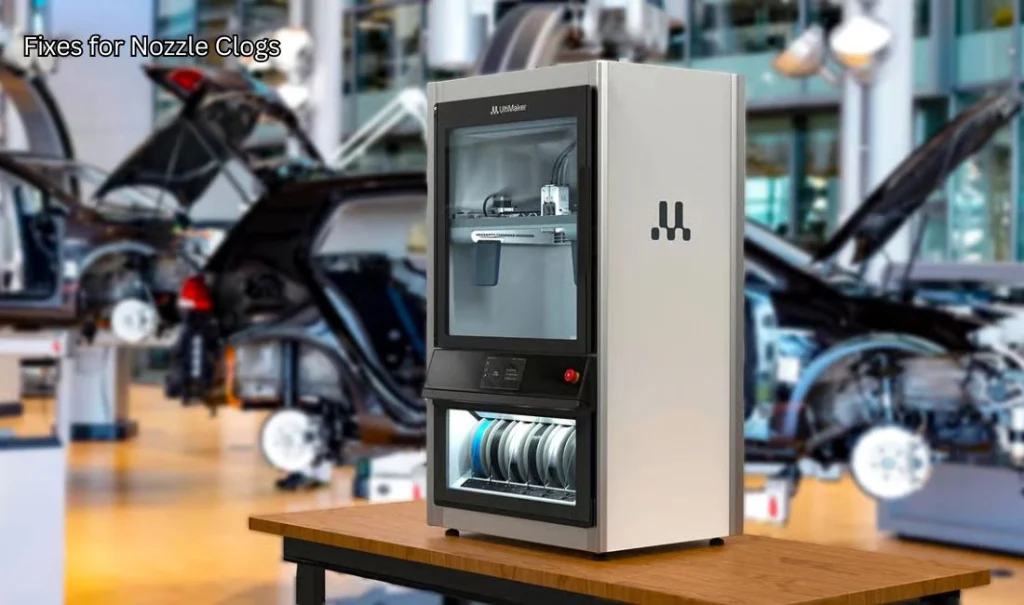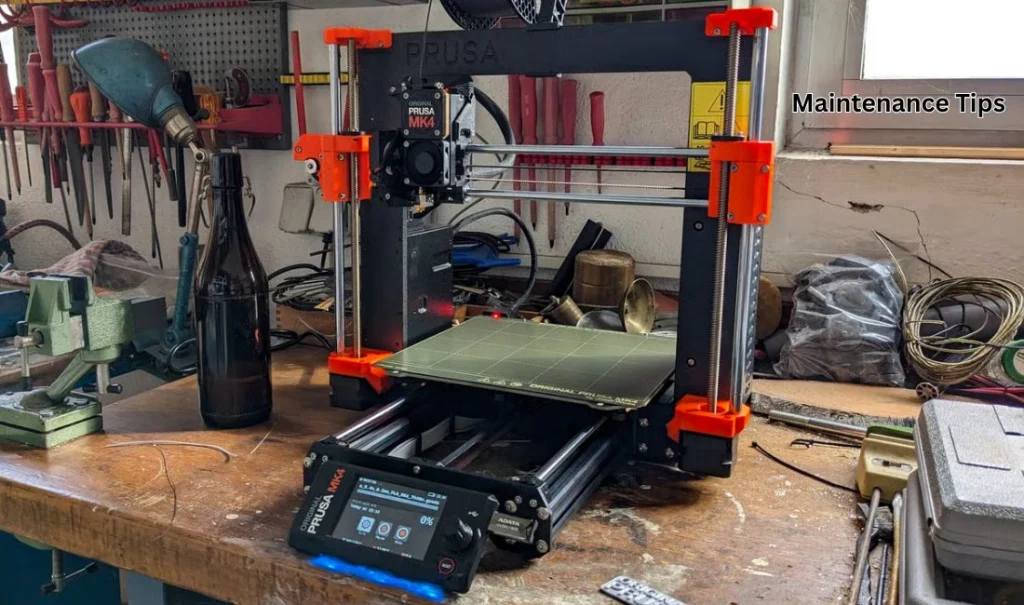Nozzle clogs are one of the most common and frustrating issues in 3D printing. When a 3D Printer Nozzle Clog happens, you start a print and everything seems fine—until the filament stops extruding, the nozzle clicks, or the printer starts printing in mid-air.
The good news? Nozzle clogs are entirely preventable and fixable once you understand their causes. In this guide, we’ll explore why nozzles clog, how to fix them, and how to prevent future issues. Whether you’re a beginner or an experienced user, this guide will help you keep your printer running smoothly.
Choosing the Best Budget 3D Printer can also reduce clog issues. A good starter machine offers smooth extrusion and fewer problems—perfect for beginners learning the basics.

Why Do Nozzles Clog? (The Real Causes)
Understanding the root causes of nozzle clogs is the first step to solving and preventing them. Here are the seven most common reasons:
1. Filament Moisture (The Most Common Cause)
Filaments absorb moisture from the air, particularly those made from materials such as PLA, PETG, and TPU. When a wet filament is heated, the moisture inside boils, creating steam that leaves behind burnt residue. This residue builds up inside the nozzle, eventually causing a clog.
Symptoms of Wet Filament:
- Popping or crackling sounds during printing.
- Stringy or bubbly prints.
- Brittle or weak layers.
How to Fix It:
Dry the filament using an oven (50–60°C for 4–6 hours), a filament dryer, or a food dehydrator. For long-term storage, keep filament in airtight containers with silica gel.
2. Dust or Dirt Entering the Hotend
Even clean-looking filament can collect dust over time, especially if it’s left exposed. Dust particles melt inside the nozzle and form blockages.
Solution:
Use a filament oiler or cleaner—a small sponge that wipes the filament clean before it enters the hotend. This simple tool prevents dust from causing clogs and is an inexpensive, long-term solution.
3. Printing at the Wrong Temperature
Incorrect nozzle temperatures are a common cause of clogs. If the temperature is too low, the filament doesn’t melt properly, creating back pressure. If it’s too high, the filament burns and leaves charred bits inside the nozzle.
Correct Temperature Ranges:
| Material | Nozzle Temp (°C) |
|---|---|
| PLA | 200–215°C |
| PETG | 230–245°C |
| ABS | 235–260°C |
| TPU | 220–240°C |
| Nylon | 250–265°C |
Always check the filament manufacturer’s recommendations, as different brands may have slightly different temperature requirements.
4. Heat Creep (Inside the Hotend)
Heat creep occurs when heat travels up the nozzle into the cold end of the hotend. This softens the filament too early, making it rubbery and prone to clogging.
Common in:
- PLA (due to its low melting point).
- All-metal hotends.
- Enclosed printers with poor cooling.
How to Fix It:
- Lower the printing temperature slightly.
- Increase the cooling fan speed.
- Upgrade to a better hotend fan.
- Print slower, especially with PLA.
5. Cheap Filament with Impurities
Low-quality filament often contains impurities such as dust, metal particles, or inconsistent diameters, which can easily clog the nozzle.
Solution:
Invest in reputable filament brands, such as Overture, Bambu Lab, or Polymaker. While cheap filament may save money upfront, it can damage your hotend and lead to frequent clogs.
6. Worn PTFE Tube or Heat Break
Over time, PTFE tubes degrade due to exposure to heat. When the tube burns or shrinks, the filament catches on it, causing a clog.
How to Fix It:
Inspect the PTFE tube for discoloration or damage. If the end is burnt, cut off 2–3mm or replace the entire tube. For all-metal hotends, ensure the heat break is clean and properly aligned.
7. Old Filament Burning Inside the Nozzle
When the filament stops mid-print, the leftover material inside the nozzle burns and carbonizes. This narrows the extrusion path, leading to clogs.
Solution:
Perform a cold pull to remove burnt residue and micro-particles (explained below).

How to Fix a Nozzle Clog (Step-by-Step Guide)
Fixing a clogged nozzle doesn’t have to be complicated. Here are five effective methods:
Method 1 — Raise Temperature + Extrude Manually
For minor clogs, heat the nozzle 10–20°C above the normal printing temperature and manually extrude the filament. If the filament flows, the clog is cleared. Print a purge line to clean out any residue.
Method 2 — Cold Pull (Most Effective Method)
The cold pull is a reliable method for removing burnt residue and micro-particles. Heat the nozzle to 220°C, insert the filament, and push until it flows. Cool the nozzle to 90°C (for PLA) or 130°C (for Nylon), then pull the filament out forcefully. Repeat until the filament tip comes out clean.
Method 3 — Clean the Nozzle with a Needle
A cleaning needle can open the melt zone and clear blockages. Heat the nozzle to the printing temperature, insert the needle, and gently move it up and down. Avoid forcing it, as this can damage the hotend.
Method 4 — Remove Nozzle & Clean It
For hard clogs, remove the nozzle and clean it externally. Heat the nozzle to loosen it, then use a wrench to remove it. Burn off residue with a butane torch and scrub with a brass brush. Reinstall the nozzle once it’s clean.
Method 5 — Replace the Nozzle
If you’ve printed 15–20 spools, your nozzle may be worn out. Brass nozzles wear out the fastest, while hardened steel nozzles last much longer. Replacing the nozzle is often easier than cleaning it.
How to Prevent Future Nozzle Clogs
Prevention is always better than fixing. Here are some tips to keep your nozzle clog-free:
- Keep filament dry: Store it in airtight containers with silica gel.
- Do a cold pull regularly: This removes buildup and keeps the nozzle clean.
- Use a filament cleaner sponge to prevent dust from entering the hotend.
- Purge between filaments: Switching materials without purging can cause clogs.
- Replace nozzles regularly: Brass nozzles are cheap and easy to replace.
- Avoid idling the nozzle: Leaving the hotend heated for too long can cause the filament to burn.
Best Nozzles to Prevent Clogging
Investing in high-quality nozzles can help prevent frequent clogs. Some reliable options include:
- Bambu Lab Hardened Steel Nozzle: Ideal for abrasive filaments like carbon fiber.
- Creality Stainless Steel Nozzle Set: Affordable and durable.
- Micro-Swiss Plated Brass: Great for PLA and PETG.
- TriangleLab Nozzles: High precision at a low cost.
Additional Causes of Nozzle Clogs
1. Misaligned Nozzle or Heat Break
A misaligned nozzle or heat break can obstruct the filament’s flow, leading to clogs. This often happens if the nozzle isn’t properly tightened or if there’s damage to the heat break. Regularly inspect and align these components to ensure smooth extrusion.
2. Filament Contamination
Dust, debris, or moisture in the filament can accumulate inside the nozzle, causing blockages. Always store filament in a clean, dry environment and handle it carefully to avoid contamination.
3. Partially Molten Filament Build-Up
Over time, partially melted filament can accumulate inside the hotend, especially during long printing sessions or with improper retraction settings. This build-up narrows the nozzle’s channel, leading to clogs. Optimize retraction settings and clean the nozzle regularly to prevent this.
4. Nozzle Wear from Abrasive Filaments
Filaments like carbon fiber, metallic, or wood-infused materials are highly abrasive and can wear down the nozzle over time. This wear can lead to uneven extrusion and clogs. Use hardened steel or ruby-tipped nozzles for abrasive filaments.

Advanced Fixes for Nozzle Clogs
1. Solvent Method
For soluble materials like PVA, soak the nozzle in a compatible solvent for 24 hours. This dissolves the clog, making it easier to clean with a needle or brush.
2. Acupuncture Needles or Guitar Strings
Thin, strong tools like acupuncture needles or steel guitar strings can be used to manually dislodge clogs. Heat the nozzle to the filament’s printing temperature, then gently insert the tool to break up the blockage.
3. Nozzle Replacement
If cleaning methods fail or the nozzle is worn out, replacing it is often the best solution. Ensure the new nozzle is compatible with your printer and properly tightened to avoid leaks.

Preventive Maintenance Tips
1. Regular Cleaning
Clean the nozzle, heat sink, and extruder regularly to remove residue and debris. Use cleaning filaments periodically to flush out buildup inside the nozzle.
2. Optimize Retraction Settings
Improper retraction can leave filament residue inside the nozzle, leading to clogs. Experiment with retraction distance and speed to find the optimal settings for your printer and filament.
3. Use Larger Nozzles for Abrasive Filaments
When printing with materials such as carbon fiber or wood-infused filaments, use a larger nozzle (e.g., 0.6mm or 0.8mm) to minimize the risk of clogs. Adjust slicer settings to account for the increased nozzle size.
4. Monitor Long Printing Sessions
During extended prints, heat can accumulate in the hotend, increasing the risk of clogs. Schedule breaks to clean the nozzle and check for any buildup.
Material-Specific Guidelines
- PLA: Ensure proper cooling to prevent heat creep.
- ABS: Maintain consistent high temperatures to avoid hardening inside the nozzle.
- PETG: Clean the nozzle regularly, as PETG can leave sticky residues.
- TPU: Print at slower speeds to prevent jamming.
- Wood or Carbon Fiber Filaments: Use hardened steel nozzles and clean frequently to remove residue.
Bowden Tube-Specific Issues
Bowden tube printers are more prone to clogs due to the longer filament path. Ensure the tube is clean, properly aligned, and free of kinks. Replace worn or deformed PTFE tubes to maintain smooth filament flow.
Proactive Measures for Long-Term Reliability
- Hot-Tighten the Nozzle: Always tighten the nozzle while it’s hot to ensure a proper seal and prevent leaks.
- Check Filament Diameter: Use high-quality filament with consistent diameter to avoid extrusion issues.
- Upgrade Cooling Systems: Improve hotend cooling to prevent heat creep, especially in enclosed printers.
- Purge Between Filaments: When switching materials, purge the nozzle thoroughly to remove any residue from the previous filament.
Summery
Nozzle clogs can be frustrating, but they’re easy to fix and even easier to prevent once you understand the causes. Most clogs result from wet filament, incorrect temperatures, or dust buildup. By following the tips in this guide, you can keep your 3D printer running smoothly and enjoy hassle-free printing. Happy printing!
Frequently Asked Questions
Why does my 3D printer nozzle keep clogging?
Nozzle clogs happen due to filament moisture, dust or debris, incorrect temperatures, heat creep, or residue buildup. Cheap or abrasive filaments and worn PTFE tubes can also cause clogs. Identifying the root cause is key to prevention.
How do I fix a clogged nozzle?
You can fix a clogged nozzle by:
Replacing the nozzle if it’s worn or severely clogged.
Raising the temperature and manually extruding filament.
Performing a cold pull to remove residue.
Using a cleaning needle to dislodge blockages.
Removing and cleaning the nozzle with a solvent or heat.
How can I prevent nozzle clogs?
Keep filament dry in airtight containers.
Use a filament cleaner sponge to remove dust.
Regularly clean the nozzle and hotend.
Purge the nozzle when switching filaments.
Use high-quality filament and avoid idling the nozzle at high temperatures.
Why does PLA clog more often than other filaments?
PLA has a low melting point, making it prone to heat creep. It can soften prematurely in the hotend, causing blockages. Proper cooling and temperature settings can help prevent this.
Do smaller nozzles clog more easily?
Yes, smaller nozzles (e.g., 0.2mm) are more sensitive to dust, debris, and residue buildup compared to larger nozzles (e.g., 0.4mm or 0.6mm). Regular maintenance and clean filament are essential to avoid clogs.
